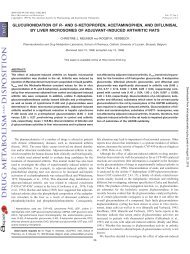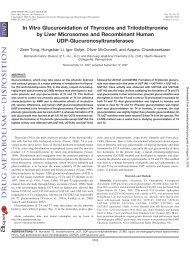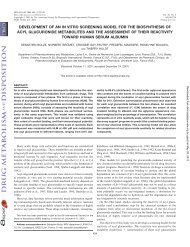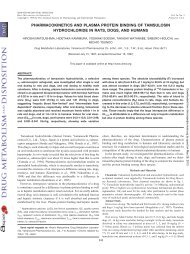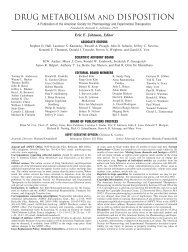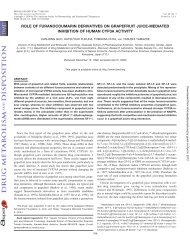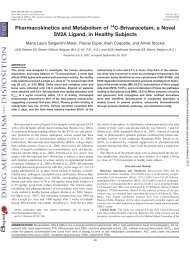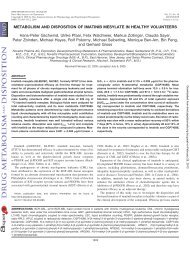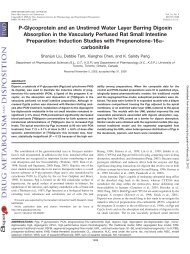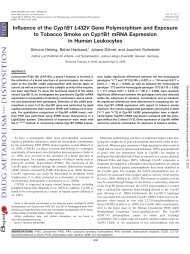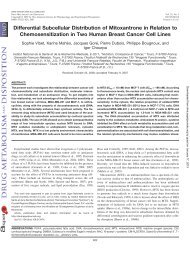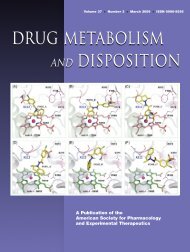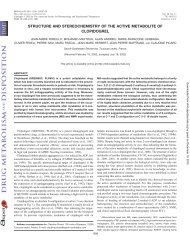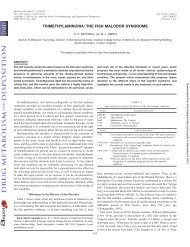DMD #048264 1 Discovery and Characterization of Novel, Potent ...
DMD #048264 1 Discovery and Characterization of Novel, Potent ...
DMD #048264 1 Discovery and Characterization of Novel, Potent ...
You also want an ePaper? Increase the reach of your titles
YUMPU automatically turns print PDFs into web optimized ePapers that Google loves.
<strong>DMD</strong> <strong>#048264</strong><br />
supernatant was then analyzed by LC-MS/MS. The metabolic stability <strong>of</strong> telmisartan <strong>and</strong><br />
flunarizine in HLM was also evaluated by incubating the compound (1 μM) in a mixture<br />
containing 0.5 mg/mL human liver microsome, 100 mM potassium phosphate buffer<br />
(pH=7.4), <strong>and</strong> 10 mM NADPH for 30 minutes. The quenching procedure was the same<br />
as in the CYP2J2 Inhibition Study section. Samples were then centrifuged at 4000<br />
RPM for 10 minutes at 4°C <strong>and</strong> supernatant was analyzed by LC-MS/MS.<br />
Time-dependent Inhibition Study. The time-dependent inhibition (TDI) <strong>of</strong><br />
CYP2J2 by telmisartan <strong>and</strong> flunarizine was measured based on a traditional IC50 shift<br />
method. Test compounds were pre-incubated at eight different concentrations (from<br />
0.023 to 50 μM) with recombinant CYP2J2 protein (1 pmol/mL) in the presence <strong>and</strong><br />
absence <strong>of</strong> NADPH (1 mM) for 30 minutes. The reaction was initiated by adding 0.15<br />
μM astemizole <strong>and</strong> incubated for 10 minutes. The quenching procedure was the same as<br />
in the CYP2J2 Inhibition Study section. Samples were then centrifuged at 4000 RPM<br />
for 10 minutes at 4°C <strong>and</strong> supernatant was analyzed by LC-MS/MS.<br />
Analytical Method. All samples were analyzed on an Applied Biosystems API<br />
4000 triple quadrupole mass spectrometer coupled with an Agilent 1200 HPLC system.<br />
For AST <strong>and</strong> DES-AST detection, the chromatographic separation was carried out on a<br />
Phenomenex Synergy Hydro-RP column (50×3.0 mm, 4 μm particles) with the gradient<br />
<strong>of</strong> 30%-100%-100%-30%-30% B was applied at 0-0.3-1.8-1.9-3.0 minute marks,<br />
respectively, in which the mobile phases A <strong>and</strong> B were water <strong>and</strong> methanol (both<br />
containing 0.1% formic acid), respectively, at a flow rate <strong>of</strong> 0.6 mL/min an injection<br />
volume <strong>of</strong> 5 μL. The mass spectrometer was operated under the positive ion detection<br />
mode using the transitions m/z 459→218 for AST, m/z 445→204 for DES-AST, <strong>and</strong> m/z<br />
271→172 for tolbutamide, respectively. The collision energy was 35, 30, <strong>and</strong> 18 eV for<br />
10



